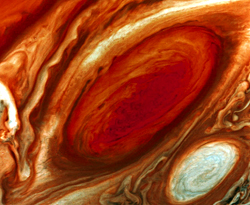DK Science: Jupiter
Jupiter is the biggest planet in our Solar System, eleven times bigger in diameter than Earth and two and a half times more massive than all the other planets put together. Jupiter has no solid surface. Beneath the gas clouds lies hot, liquid hydrogen, then a layer of hydrogen in a form similar to liquid metal, and finally a rocky core. Jupiter has a faint ring around its equator made of microscopic dust particles.
In 1609, the Italian astronomer Galileo first spied Jupiter’s four largest moons: Io, Europa, Ganymede, and Callisto. The largest Galilean moon, Ganymede, with a diameter of 5,268 km (3,273 miles), is also the biggest moon in the Solar System.
Alternate dark and pale bands streak Jupiter’s atmosphere. The dark bands are called belts and the pale ones are called zones. The different colours reflect the presence in the atmosphere of different chemicals, such as sulphur, ammonia, and phosphorus compounds.
There are light displays, called auroras, at Jupiter’s poles, like the Northern and Southern Lights we see on Earth. But on Jupiter the displays are much more dramatic. Lightening bolts 10,000 times more powerful than any seen on Earth also light up the planet.

